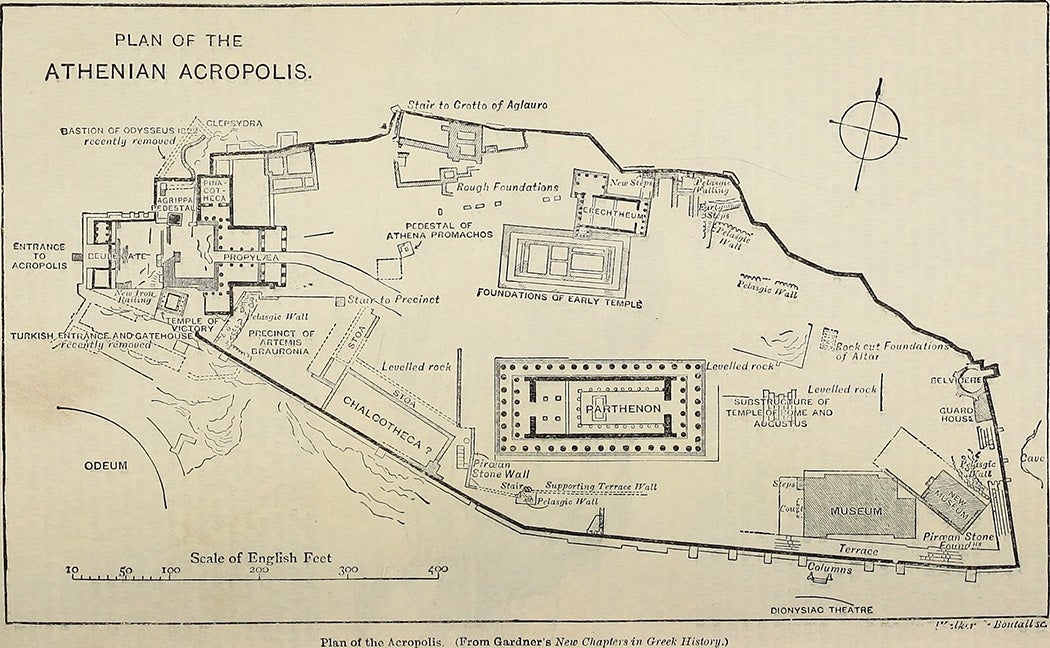Rising above Athens, the Acropolis is the temple complex from the ancient Greek world. The Periclean building campaign that resulted in the iconic Parthenon and other structures of the Acropolis defined the “golden era” of classical Athens. Today, it’s one of the most important tourist destinations in the city. And while you can find many images of visitors posing in front of the Parthenon, there’s another temple of the Acropolis whose irregularities are still of great debate today.
While the Parthenon embodies the ideals of perfection the Greeks sought from architecture during the Classical period, the Erechtheion is more unusual. Split across two elevations, the Erechtheion is essentially two temples squished into one. Its eastern portico, sitting on higher ground, marks the entrance to the portion of the temple dedicated to Athena Polias. A revered olive-wood statue of the goddess was housed in its cella (the inner room of the temple). The northern portico is about ten feet lower than the eastern one and serves as the entrance to the western section of the temple. There one finds shrines to Poseidon-Erechtheus, Hephaistos, and Boutes. This unexpected layout challenges the Greek canon of the perfectly arranged, symmetrical temple.
So why does the Erechtheion look the way it does? Well…it’s complicated. And scholars are still debating it.

One leading theory, writes historian Henrik Gerding, “is that the architect behind the Erechtheion wanted to combine the Temple of Athena Polias with other shrines and religious tokens related to the birth of the city.” Though replacing the old Temple of Athena Polias destroyed by the Persians in the sacking of Athens in 480 BCE, the Erechtheion wasn’t an exact copy. Far from it! As with the original, it would serve as the home of the cult statue of Athena Polias and be the main shrine to her. But it would also reference the competition between Athena and Poseidon to be the patron god of Athens (hint, hint, Athena won). The three-part western shrine honors Poseidon-Erechtheus (Erechtheus was the mythical founding king of Athens), Boutes (Erechtheus’s brother), and Hephaistos, the god of fire and forge. The design of the Erechtheion thus honors the old Temple of Athena Polios while incorporating the mythology of the birth of Athens.
Further complicating the temple’s design is its placement within the Acropolis. On the Erechtheion’s southern side stands the Porch of the Maidens, with its six caryatids (statues of women serving as columns) gazing across to the Parthenon. Between the Porch of the Maidens and the Parthenon is the space that once was home to the old Temple of Athena Polias. Why not just replace the old Temple of Athena, instead of building the unusual Erechtheion?
The classical archaeologist and art historian Gloria Ferrari Pinney looked to the “Oath of Plataea” as an explanation for this perplexing space. In this oath, the Greeks “pledged never to rebuild the shrines of the gods destroyed by the barbarians.” The ruins of the old temple remained as an eternal reminder of the devastation wrought by the Persians on the site. Ferrari writes that “[f]ar from being unsightly rubble, the ruin at the heart of the Acropolis functioned as the point of relay to which the other buildings responded.”
Knowing this context helps us understand the Erechtheion’s unusual placement and layout, especially when considering the massive building campaign seen atop the Acropolis at the time it was being built.
Weekly Newsletter
However, Gerding hypothesizes that the disposition of the Erechtheion relates more to the overall use of space within the Acropolis than a concern with memorializing the Persian invasion. He argues that, in deciding to the Erechtheion just north of the site of the original Temple of Athena Polias, “the principle aim must have been to create a larger and centrally placed open space on the Acropolis for the gatherings of people.” As crowds for the annual Panathenaic procession grew, a larger space was needed to allow worshippers to gather in front of the Great Altar. Moving the Erechtheion to the north and giving it an unexpected layout would have achieved this goal.
While scholars continue to debate the motivations behind the Erechtheion’s design, what remains is an unusual Greek temple whose differences are only heightened by its proximity to the perfectly proportioned, utterly iconic Parthenon.
Support JSTOR Daily! Join our membership program on Patreon today.







